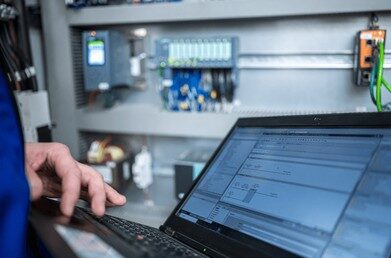PLC Programming

PLC Programming
Programming Languages
User-Friendly Software
Real-Time Processing
Modular Design
Communication Protocols




PLC Programming
Overview:
At Safe and Sure Projects Pvt. Ltd., we specialize in PLC (Programmable Logic Controller) programming, a cornerstone of industrial automation. PLCs are essential for controlling machinery and processes in various industries, ensuring efficiency, reliability, and safety.
PLC programming involves creating a set of instructions that a PLC follows to perform specific tasks. These tasks can range from simple operations to complex processes in manufacturing, energy management, and more.
Key features:
User-Friendly Interfaces: Our programming solutions utilize intuitive software platforms, making it easy for operators to monitor and control processes.
Versatile Programming Languages: We employ multiple programming languages, including Ladder Logic, Function Block Diagram, and Structured Text, to meet diverse application needs.
Real-Time Monitoring: PLCs provide real-time data and feedback, allowing for immediate adjustments and optimizations in operations.
Integration Capabilities: Our PLC systems can seamlessly integrate with other automation components, such as SCADA systems and sensors, ensuring a cohesive operation.
Scalability: Our programming solutions are designed to be scalable, accommodating the growth of your operations without significant overhauls
Applications:
Streamlining assembly lines for efficient production,coordinating machinery and equipment for optimal performance.
Process Control: Regulating chemical processes in industries such as pharmaceuticals and food production,monitoring and controlling temperature, pressure, and flow rates.
Material Handling: Automating conveyor systems for seamless product movement,managing robotic systems for packaging and sorting.
Building Automation: Monitoring and controlling chemical dosing and filtration systems.
Energy Management: Integrating renewable energy sources with grid systems.monitoring energy consumption and optimizing usage.
Automotive Industry: Controlling robotic assembly lines for vehicle manufacturing,implementing quality control systems for inspection and testing.
Food and Beverage Processing: Automating bottling and packaging lines for efficiency,ensuring consistent quality through automated monitoring systems.
Our Other Automation Services

Industrial Automation

Electrical Designing

Digitalization Solutions


